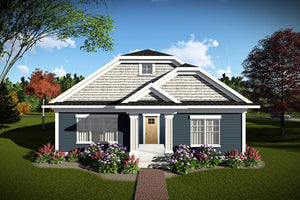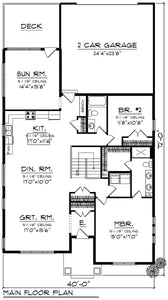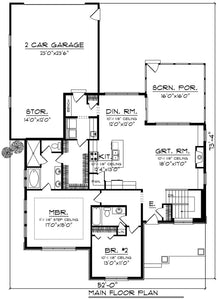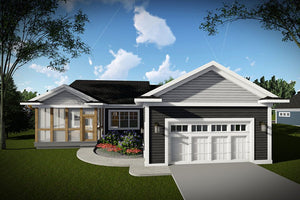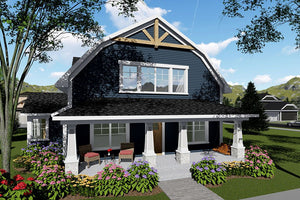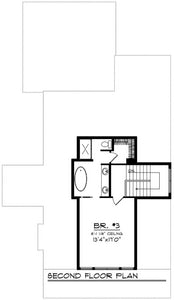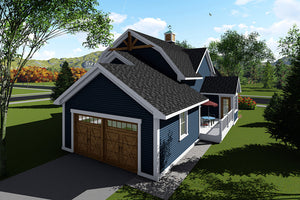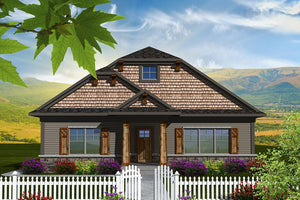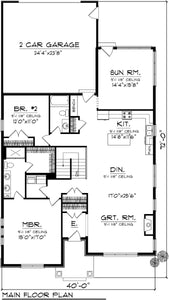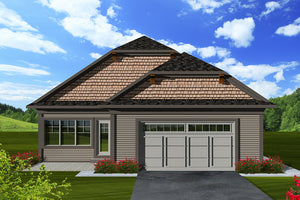Best Selling Alley Load House Plans
In Alley Load homes the garage entrance is located at the rear of the home, usually off of an alley that runs behind the home. These homes are aesthetically pleasing because the garage door is tucked behind the house leaving the front of the home for porches and other design features. Alley load homes are also ideal when building on a narrow or corner lot.
Common Alley Load House Plans Questions
What is an Alley Load house?
When cars first became prominent in American lifestyles, they were parked at the rear of the homes where detached garages were located so that they wouldn't interfere with the design aesthetics and functions of the front of the home. Garages were considered to be for storage, and the front of the home was where social interaction happened as sidewalks were placed in the front of the homes. In the 40s and 50s, most garages were detached and if you look around your local community at some of the older neighborhoods, you'll surely find many homes with the garage in the rear.
We have become so accustomed to seeing garage-fronted homes that we almost don't understand what we're looking at when we see a home without one. Alleys take the garages off the street and "tuck" them out of sight in the rear of the home.
An urban explosion of alley loaded homes has been happening in the past few years in larger communities and is gaining traction in both urban and suburban areas around the country. In communities where a lot of infill building is happening, builders are opting to buy up several older homes and replace them with several alley-load house plans because these homes typically have a narrower footprint. Alley-loaded streets take cars away from the road which can give families a safer place to walk, play and meet each other, and spend time outdoors just like they did when they were young.
Why are Alley Load house plans becoming more popular?
There are several reasons that these neighborhoods are popping up across American. For cities, it's an easy way to increase density in an older neighborhood where houses are becoming rather run down and the need for redevelopment is strong. More density means more houses, and more houses per square foot on a lot equals more in tax dollars to help maintain those homes and streets. We are seeing plenty of infill projects where a block of run down houses has been demolished and replaced with Alley Load homes.
Another reason that Alley Load house plans are increasing in demand is that builders are looking for ways to appeal to first time home owners and these plans are typically smaller in size, more narrow in width and the perfect place to start a family. The addition of alleys and Alley Load homes started in developed, older communities and is now spreading to new housing developments in suburban areas where on street parking is not allowed.
There are also many people who do not like the look of a large garage on the front of the home and would rather have an Alley Load to keep the front of the home aesthetically "available" for things like large porches and covered entries. Safety is also a large concern for young families, and by putting the garages to the rear, many cars are eliminated from traveling down the streets between the homes.
What kind of lot do I need for an Alley Load home?
You'll need to look for a lot that has alley access to build one an Alley Load house plan, and they might be tricky to find in a new neighborhood, but they are out there if you're willing to put the time in to search. Another option would be for you to buy and tear down a house in an older neighborhood where garages are most likely detached and facing an alley off the back of the home.
It's important to remember that you'll most likely be looking for a narrow lot. The good news is that many of our Alley Load homes are designed for a narrow frontage since the garages are not present to make up the majority of the front of the home. New neighborhoods are also popping up in developing suburban areas where the live/walk concept that is created by Alley Load homes allows for sidewalks, streets and front porch areas for socializing and safety.
What's the bottom line?
Today's builders are looking for ways to increase density within the neighborhoods they are developing, and they are often master-planning entire developments that allow for alleys. Charming homes with angled garages located in the rear off those alleys allow for aesthetically pleasing house plans to choose from, and homeowners of every age are rapidly snapping up these homes.
Imagine streets with no cars parked along the curbs. Imagine front porches and white picket fences. These are just a few of the attractive results of owning an Alley Load home in a master-planned community. Seniors and first-time homebuyers alike are interested in the safety and social aspect that is often created in an Alley Load neighborhood.
Alley Load homes are typically more narrow in width, with smaller back and side yards to take care of. Patio areas off the alley are typical, but the front yard is where all of the social action is. Floor plans are usually open-concept and Alley Load homes can be either ranches or 2-stories. You'll also find Alley Load homes being built as infill projects as well as in completely newly developed neighborhoods with the white picket fences.







